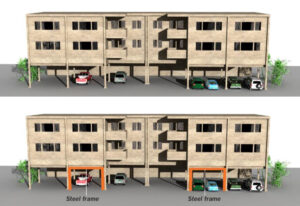Futureproofing our Infrastructure
There are two primary issues related to natural hazard events such as earthquakes or floods. They generally don’t occur that often, but when they occur, they can be devastating, causing billions of dollars in damages and threatening the loss of life.
Having in place measures that would help minimize damages from such events and lower the risk of fatalities is the essence of resiliency planning. But getting the engineering, economic, environmental, and public policy measures in place to strengthen the resiliency of communities or businesses is a very tough job that is often left undone.

Evan Reis
These were the observations aired by Evan Reis, Co-founder and Executive Director of the U.S. Resiliency Council, in a keynote address on Futureproofing Our Infrastructure at the recent Pacific Northwest Economic Region Summit in Calgary, Alberta.
From an engineering perspective, we know already which building types can better withstand the impacts of extreme natural events, he noted, and what we must do to make our infrastructure more resilient. But there are so many short-term issues in play at any given time that the development and implementation of long-term strategies to address these issues often are left undone or incomplete.
He outlined the work of the U.S. Resiliency Council to make sure that engineers, insurance companies, financiers, building owners, public officials, and people, in general, are aware of the risks they face from extreme weather or natural disaster events.
What is needed today, he suggested, given the increased number of floods, wildfires, and temperature extremes, is a strategic approach that makes the benefits of long-term resiliency measures acceptable as short-term actions. He outlined a four-stage process to make this possible for businesses, property owners, government officials, and insurance companies.
Make People Aware
First and foremost, he suggested, everyone must be made aware of the risks they face from natural disasters. Everyone must be mindful of their risks and liabilities from the perspective of the State, Provincial, and community levels. That way, property owners and business leaders can make the right decisions to strengthen the resiliency of their holdings.
Make The Case
The second strategy is to get the engineering knowledge already in place to serve the equity, environmental, and economic tools we can use today to withstand the impacts of earthquakes, floods, and wildfires, not only in terms of the performance of buildings and infrastructure but also in terms of how socially vulnerable communities and our economy will be affected by such events.
Build The Coalition
The third element of the strategy is stakeholder engagement. Everyone potentially affected by the lack of resilience of buildings or infrastructure must understand the risks and benefits to themselves as tenants, building owners, Chambers of Commerce, environmental organizations, lenders, or city officials if and when natural disasters occur.
As opposed to showing engineering calculations, we can bring those types of stakeholders on board by showing them the return on resiliency investment in terms of reduced risks, lower damages, and faster recovery from disasters.
Be Part of the Solution
Finally, there is a need to translate long-term thinking into short-term incentives. Often the low probability of natural disaster events turns away short-term thinking by building owners or legislators. “So it’s essential to translate the benefits of the long-term resiliency perspective into short-term benefits the same way we amortize a mortgage into short-term incentives to help to build owners in their investment plans. That way, we can get resiliency investments into short-term action plans,” he noted.
A Real World Example of the Strategic Approach

Retrofitting Soft Story Buildings
Reis illustrated the use of this strategic approach in terms of resiliency retrofits for small multi-family ‘Soft Story’ apartment buildings with one or two stories of housing on top of open front parking with nothing underneath to support the building in the event of an earthquake. (See illustration)
The per unit cost to the primarily mom-and-pop pipe owners of these predominantly lower-income properties housing elderly or disabled folks would be about $5,000 to $10,000. This compares to the current cost of building new comparable housing units in California, which run between $500,000 to $700,000 per unit.
He noted that legislation signed by California Governor Newsom in June would allocate matching money to property owners to pay for such retrofits. This is a classic example of translating the longer-term resiliency benefits into short-term incentives that stakeholders can act upon today.
In summing up his message, Reis noted the key to this strategic approach is to dispel the myths around liability and return on investment and to find solutions that everybody can latch onto by turning long-term investment decisions into short-term incentives. Whether retrofitting older buildings or designing new ones to higher performance levels, they all have an impact that is too important to miss when futureproofing our infrastructure.
USRC Punches 1000 Times Above its Weight
The U.S. Resiliency Council, a relatively small nonprofit with a $250,000 budget, successfully advocated a $250,000,000 law by gathering together a coalition of 45 organizations where everyone could see a positive return on investment and where everybody benefited, noted William Larson, Chair of the Pacific Northwest Building Resilience Coalition, the sponsors of Evan Reis’s presentation.
“Evan’s message is important,” he noted, “as we are also finally seeing the development of state and federal legislation addressing the importance of resilient design as in the US Resilient America Act, which expands coverage for hazard mitigation to property owners. California’s $250 million allocation to assist property owners of soft-story structures with seismic retrofits is a classic example of how we can build a more resilient future for everyone.”.
__________________________________________
Evan Reis is a California structural engineer and an executive director of the U.S. Resiliency Council. He works with public and private organizations to promote resilience and improve the performance of our nation’s infrastructure from natural disasters. More details on the work of the U.S. Resiliency Council to promote the seismic retrofits of Soft Story buildings in California are available here. The Pacific Northwest Building Resilience Coalition has supported the U.S. Resiliency Council and sponsored presentations by Evan Reis at the 2022 and past Summits of the Pacific Northwest Economic Region. A video of Evan Reis’s presentation will be available presently.







